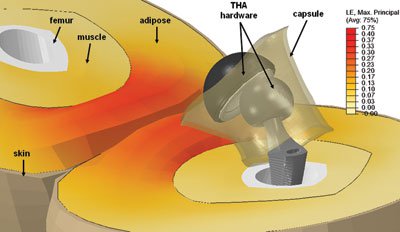THA dislocation in morbidly obese due to head slide-out or shear-out mechanism
Researchers found that contact between the patients’ thighs during sit-to-stand activities increased the risk of dislocation/subluxation with BMI greater than 40.
 Jacob M. Elkins |
Hip dislocation mechanisms in morbidly obese individuals differ from those in normal weight individuals, which may require changes in head size and offset, according to University of Iowa researchers.
The validated finite element model they used to study this area accounted for differences in total hip arthroplasty (THA) hardware, amount of hip joint soft tissue in obese individuals, and variations in left vs. right thighs, said Jacob M. Elkins, who presented the results at the 2011 Orthopaedic Research Society (ORS) Annual Meeting.
“Our take home message … was that high offset and horizontal cup placements were the two most important risk modifiers for this form of dislocation,” Elkins told Orthopedics Today.
Sit-to-stand simulation
In this study, one of many conducted by the group to explore impingement associated with primary or revision THA, Elkins, a graduate research assistant, and colleagues created computer models of the key variables clinically known to affect THA dislocation or subluxation in the morbidly obese. The goal was to identify which changes in those variables helped reduce the likelihood of THA subluxation.
While different maneuvers or movements put obese patients at risk of post-THA instability, the Iowa team limited its investigation to sit-to-stand motions and the leg adduction associated with them, Elkins said. When they simulated the motions using 28-mm heads with a metal-backed liner, subluxation from head slide-out occurred in 30 of 120 models, often during hip extension at the conclusion of sit-to-stand movement. Dislocation risk was highest in models with a body mass index (BMI) of 40 and with higher cup abduction.
|
Image: Elkins JM |
High neck offset helps
Increasing head size to 36 mm in a second 120-simulation model did not affect subluxation risk, and BMI of 40 and above remained the cutoff value for increased risk, Elkins said. “The larger head provided some stability in that with the 28-mm head we saw subluxations with cups orientated at 30° and 35° and the larger head seemed more stable at the more horizontal cup placements.”
A third round of simulations with a 36-mm head and high neck offset “dramatically improved stability. We got zero dislocations in this series and minor subluxation, only at very high cup orientations,” he said.
Among the study limitations were simulating thigh shape and spacing between the thighs, which investigators set at 200 mm, Elkins said.
He noted how important weight loss prior to THA can be in these patients. “Given … our work, there really is a legitimate concern with thigh impingement leading to instability. There are some factors that are surgeon-controlled, such as cup orientation and the individual components used, but I believe for many reasons, not just for dislocation risks, a patient who is committed to losing weight before a procedure will see benefits in many areas.” – by Susan M. Rapp
Reference:
- Elkins JM, et al. Total hip instability in the morbidly obese patient — A finite element exploration. Paper #14. Presented at the 2011 Orthopaedic Research Society Annual Meeting. Jan. 13-16. Long Beach, Calif.
- Jacob M. Elkins, can be reached in the Department of Orthopaedics and Rehabilitation, University of Iowa, Iowa City, IA; 319-335-7539; e-mail: jacob-elkins@uiowa.edu.
Disclosure: The study was financially supported by the VA Medical Research Program. Elkins has no relevant financial relationships; however, he noted that co-authors of the study are consultants to Smith & Nephew and Depuy, a Johnson & Johnson Co.

